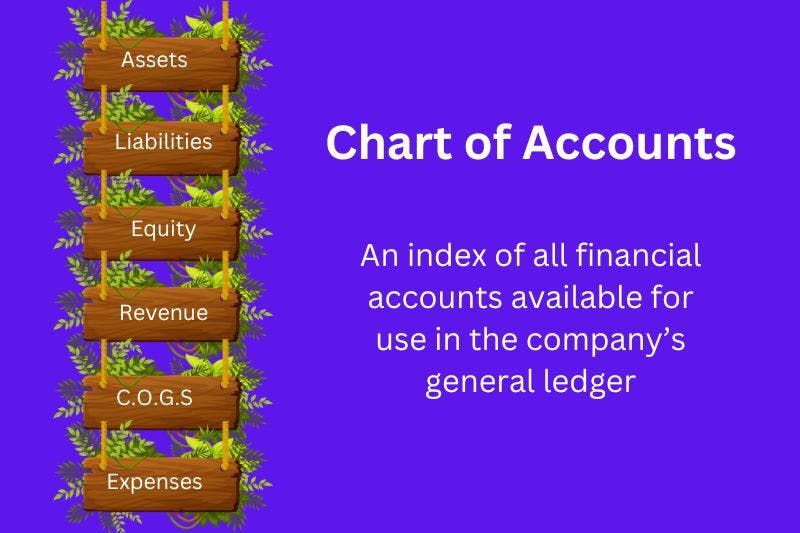
The chart of accounts is the most important template you will set up because it establishes your accounting system. It organizes the general ledger accounts for recording transactions in your business and thus provides the foundation for your financial statements.
Timely business decisions, loans, investments, funding - all rely on the financial statements, and it is the CoA that leads the way there.
The CoA also provides a method for the quick allocation of transactions according to an established system. In short, it provides a common accounting language for your business and external parties.
In this quick guide for small businesses, we explain the basics of the chart of accounts. This will help you think about how you should accurately reflect your financial transactions. We will discuss a template according to which you can structure these accounts that comply with generally accepted accounting principles (GAAP). Lastly, we will give you reasons why you should consider outsourcing your bookkeeping to an accounting firm if you have numerous accounts to manage.
Let’s get started.
Organizing your chart of accounts

Image courtesy of Canva/Getty Images
Your business is unique and your CoA should reflect that. Steer clear of allowing your accounting software to dictate the accounts chart. That might seem easier in the short term, but it won’t help you to record transactions accurately. This is usually true for expense accounts, and working with a pre-defined template tempts you to force a transaction into an account that doesn’t belong there.
The basic framework of a chart of accounts
Let’s work on a sample Chart of Accounts for a small business in Dallas Texas, trading in medical software. It might look something like this:
Account Code | Account Type | Description |
1000 | Assets | Cash and bank accounts |
1100 | Assets | Accounts receivables |
1200 | Assets | Inventory |
1300 | Assets | Prepaid expenses |
1400 | Assets | Equipment |
1500 | Assets | Intellectual property |
2000 | Liabilities | Accounts payable |
2100 | Liabilities | Accrued expenses |
2200 | Liabilities | Loans payable |
3000 | Equity | Owner’s equity |
3100 | Equity | Retained earnings |
4000 | Revenue | Software sales revenue |
4100 | Revenue | Service and maintenance |
4200 | Revenue | Licensing fees |
5000 | Expenses | Cost of goods sold |
5100 | Expenses | Development expenses |
5200 | Expenses | Marketing and advertising |
5300 | Expenses | Salaries and wages |
5400 | Expenses | Utilities |
5500 | Expenses | Insurance |
5600 | Expenses | Professional fees |
5700 | Expenses | Taxes and liabilities |
5800 | Expenses | Rent expenses |
Now, let’s examine each element so we can explain what’s going on here.
Account Codes
Account codes give you a systematic and unique way of identifying groups of financial transactions in an accounting system. These codes have several key purposes for financial reporting and management accounts.
Organization
Accounts codes help organize transitions into a structured numbering system. By assigning identification codes to each account, you can make the process of recording, tracking, and retrieving financial data easy.
There are several categories of account numbers:
Income statement accounts
Revenue accounts
Interest income
Balance sheet accounts
Equity accounts
Liability accounts
These categories can also have sub-accounts such as:
Current assets
Non-operating revenues
Current liabilities
As mentioned previously, accounting software packages will have a pre-defined number system, but don’t fall for the trap of setting up your CoA according to your software. Rather, choose software that reflects your industry or allows you to adapt your accounts to your business.
Efficiency
Using codes makes data entry quicker and reduces the chances of errors. If you’re going to use a tool to automate data entry, these codes allow the tool to recognize certain transactions and allocate them correctly.
Consistency
Codes allow consistency across different departments and accounting periods. This is crucial for accurate financial reporting over several years and for comparison data.
Reporting
By grouping similar transactions under the same financial accounts, your business can generate insights into your financial position and performance.
Compliance
All businesses are subject to some kind of scrutiny and regulatory oversight. Thus, detailed accounts help maintain records that comply with accounting standards and legal requirements.
We’ve made a great start. Let’s continue with how you structure the codes.
Structure and design of codes

Image courtesy of Canva/Getty Images
Codes are universally numeric, but that doesn’t mean you can’t use letters for clarity. The length and complexity of the accounts should be according to the needs of your business and for a small business, the simpler, the better.
The first digits represent major categories of accounts, such as assets (1), liabilities (2), equity (3), revenue (4), and expenses (5).
The second digits represent sub-codes within major categories, offering more detailed account information (1100 for Accounts receivable)
In larger organizations, additional numbers represent different departments, projects, locations, or fund allocations.
Customization
There are a few things you need to keep in mind when building your chart of accounts. Once you have decided on all the accounts, don’t use concurrent numbers. You will need to add new accounts in the future. If you don’t leave gaps between numbers, you won’t be able to do this.
For example, assume you label accounts receivable as 1001, accounts payable as 1002, and owner’s equity as 1003. Now you want to add a petty cash account, which should be under assets but you don’t have a number between your asset accounts and equity accounts. Problem.
Another great tip is: Don’t create new accounts for the sake of it. There are specific accounts needed in your business and you need to carefully think about them and plan your CoA.
If you feel you won’t be able to do it with precision, how about using the services of an accounting firm like Hall Accounting Company? As a full-service accounting firm, they have the expertise to work through your transactions and chart them into different categories. They also offer bookkeeping services for small businesses, allowing you to focus on what you do best and leave the numbers to them.
Schedule a call to discuss your accounting needs.
Ok, we’re progressing nicely now, so what’s the next step?
Implement and maintain your CoA

Integration with accounting software
This involves setting up each account with its unique code and description within the software. Many modern accounting systems offer customization options that allow businesses to tailor the COA to their specific needs. Proper integration ensures that financial transactions are recorded accurately and efficiently, facilitating real-time financial reporting and analysis.
Maintain the Chart of Accounts
Business needs and external regulatory requirements constantly evolve, making it necessary to regularly review and update the COA. This may involve adding new accounts to reflect new business activities or consolidating accounts to streamline financial reporting.
We’ve just about covered the basics of a chart of accounts. But before you go, consider what we have to say about outsourcing your bookkeeping, which will allow you to get back to doing what you love.
Outsourcing bookkeeping functions to an accounting firm
There are a couple of reasons why this is a smart idea, and your CoA being done properly is one of them.
Over the years, we’ve seen small business owners struggle to set up their accounting systems. They can’t pay for bookkeeping services, but they don’t necessarily have the skills to manage their bookkeeping. Or they’re convinced they can manage.
After struggling through the first tax year on their own and taking on a massive amount of stress during the tax filing session, they seek professional help. By then, quite a few haphazard accounting practices had been applied, and they found that their financial statements did not represent the company’s financial position correctly.
What started as a cost-saving exercise (not hiring a bookkeeping service) ends up costing double. They have to pay for their mistakes to be fixed, plus face the possibility that they have understated or overstated their income on their tax return.
Sometimes it doesn’t look like this; sometimes, they’ve done a great job of working through their accounts in the first years, but now they’re growing and losing track of the chart of accounts and need help.
Whatever the reasons for seeking bookkeeping services, there are four compelling reasons for outsourcing to an accounting firm like Hall Accounting Company.
Financial accuracy and compliance
A bookkeeper or accountant will ensure that financial records are precise and up-to-date. Making informed business decisions requires this. They are also well-versed in accounting principles and tax laws, ensuring your business complies with regulatory requirements. This helps you avoid costly financial penalties associated with errors in financial reporting or tax filings.
Time and resource savings
Outsourcing bookkeeping allows a business owner to focus their time and resources on core business activities, such as product development, marketing, and customer service, rather than getting bogged down by financial recordkeeping.
Professionals use the latest technology to manage your finances efficiently, automating much of the data entry tasks, which ensures a high degree of accuracy.
Financial insights
Bookkeeping services provide detailed and organized financial records that are essential for planning. With a clear understanding of your financial position, you can make choices about investments, expansions, or cost-cutting measures. Accurate budgeting and forecasting rely on accurate recording of financial transactions; it helps you understand your cash flow and enables you to anticipate future financial needs.
Cash flow management
An accountant can monitor your cash flow carefully, which is vital for the day-to-day operation of your business. Knowing exactly where your money is coming from and going to ensures you can cover financial obligations. Flagging significant problems such as unnecessary expenses or late payments is one aspect of cash flow management that is invaluable to a small business.
Think outsourcing is a good idea? Schedule a call.
And finally…
This brings us full circle back to the chart of accounts. None of the above-mentioned benefits are possible without a precise and adequate chart of accounts. It is the foundation for strong financial management.
In this article, we took you through the basic steps of setting up a chart of accounts and shared some suggestions for a structure. This will get the ball rolling as you set up your accounting system, and if you have any further questions, you can contact our firm directly.
Until next time, all the best to small business owners - we look forward to hearing from you.